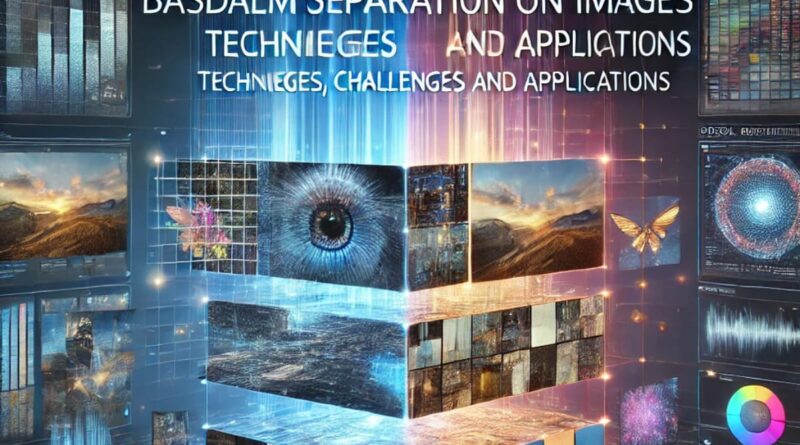Basdalm Separation on Images: Techniques, Challenges and Applications
Image Separation: A Beginner’s Guide to Deciphering Visual Complexity
Basdalm Separation on Images, Computer vision, image processing and machine learning all revolve on the idea of image separation. In order to analyze, comprehend or manipulate images further, it is necessary to differentiate between various objects, characteristics or components within the picture. Medical imaging, autonomous systems, content development and remote sensing are just a few of the many growing technological domains where picture separation is becoming more important.
Insights into the ways this process is changing industries are offered by this article’s exploration of the fundamental ideas, methodologies, and applications of image separation.
Image Separation Made Easy
Isolating certain parts or layers from a larger picture is the essence of Basdalm Separation on Images. Particular things, hues, textures or even background noise may all be considered components. To illustrate the point, one of the most important steps in medical imaging for both diagnosis and therapy planning is to isolate the tumor from the surrounding healthy tissues.
The basic purpose of image separation is to reduce complicated visual data into manageable pieces, allowing improved interpretation and decision-making. This procedure generally requires numerous approaches and tools, each adapted to the particular qualities of the picture and the intended use.
Key Techniques in Image Separation
Several techniques and algorithms are applied for image separation, ranging from fundamental approaches to complex machine learning models. Here are some regularly used techniques:
1.Thresholding
Thresholding is a basic but efficient approach for distinguishing picture components depending on pixel intensity. By setting a specified threshold value, pixels are categorized into separate groups (e.g., foreground and background). This approach is very helpful in binary picture segmentation but may struggle with photos including variable illumination conditions.
2.Edge Detection
Edge detection methods, such as Sobel, Canny and Laplacian operators, concentrate on finding boundaries between objects. By identifying substantial variations in pixel intensity, these techniques can extract forms and structures within a picture.
3.Color-Based Separation
Color segmentation focuses on differentiating items based on their color features. Techniques like clustering (e.g., k-means clustering) or color space conversions (e.g., RGB to HSV) are applied to group related colors and separate them efficiently.
4.Frequency Domain Techniques
Frequency-based approaches, such as Fourier or Wavelet transforms, examine the picture in the frequency domain. These strategies are excellent for distinguishing periodic patterns or reducing noise.
5. Deep Learning Approaches
Deep learning has revolutionized image separation using neural networks like Convolutional Neural Networks (CNNs) and Generative Adversarial Networks (GANs). These models learn complicated properties and connections inside pictures, allowing tasks such as semantic segmentation, super-resolution and background removal.
Challenges in Image Separation
While image separation is tremendously strong, it comes with challenges:
- Noise and Artifacts: Images typically include noise or distortions, which might impair proper separation. Pre-processing methods like denoising filters are important to overcome this problem.
- Overlapping Objects: When things overlap or merge in color and texture, differentiating them becomes more challenging. Advanced models with contextual awareness are typically necessary in such circumstances.
- Computational Complexity: High-resolution pictures and sophisticated separation tasks need large computing resources, making optimization crucial.
Applications of Image Separation
The benefit of image separation is demonstrated across several domains:
- Healthcare: Identifying and isolating tumors, organs or anomalies in medical imaging.
- Autonomous Vehicles: Segmenting road signs, lanes and barriers for navigation and safety.
- Satellite Imagery: Differentiating terrain types, aquatic bodies and urban regions for environmental monitoring.
- Creative Media: Removing or isolating backgrounds and objects for design objectives.
- Forensics: Enhancing or isolating components in photos for investigative reasons.
Future Trends
The future of image separation rests on the merging of AI and quantum computing. As algorithms get more sophisticated and computationally efficient, the accuracy and speed of image separation will considerably increase. Additionally, the merging of image separation with augmented and virtual reality will uncover new opportunities in entertainment and education.
Conclusion
Basdalm Separation on Images is a cornerstone of contemporary visual processing, enabling the capacity to break down complicated images into intelligible pieces. With its enormous number of methodologies and applications, image separation continues to alter industries and boost technical capabilities. As we enhance and innovate these technologies, the potential for new discoveries in image analysis remains infinite.




Pingback: Digital Art Ankinsart: Revolutionizing Creativity in the Modern Era
Pingback: KICX Sound Civilization ALS 6.2: The Best 6.5 Inch Car Speakers for